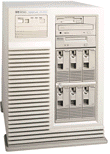|
|
|
Internet Protocol
The IP address. What are they first? Well, they are the numeric fingerprints of every machine on the Internet. Every piece of hardware has one of these addresses. The format for an IP address is in what I call the four-dot address. This is a 32-bit number, split into four 8-bit segments. It actually looks like this: 206.73.175.92 where 206 is one of the 8-bit segments. To understand how this is made up, we need to know a bit about bits, and, wait for it, a tiny bit about maths.
Each bit can be either a 0 or a 1.
Therefore an 8-bit number has either 0's or 1's or a mixture of both.
E.g. 00000000 or 11111111 or 01100101
This 8-bit number is called a byte.
IP - Scope and Interface
The Internet Protocol is designed for use in interconnected systems of packet-switched computer communication networks. Such a system has been called a "catenet" [1]. The internet protocol provides for transmitting blocks of data called datagrams from sources to destinations, where sources and destinations are hosts identified by fixed length addresses. The internet protocol also provides for fragmentation and reassembly of long datagrams, if necessary, for transmission through "small packet" networks.
Scope
The internet protocol is specifically limited in scope to provide the functions necessary to deliver a package of bits (an internet datagram) from a source to a destination over an interconnected system of networks. There are no mechanisms to augment end-to-end data reliability, flow control, sequencing, or other services commonly found in host-to-host protocols. The internet protocol can capitalize on the services of its supporting networks to provide various types and qualities of service.

Interfaces
This protocol is called on by host-to-host protocols in an internet environment. This protocol calls on local network protocols to carry the internet datagram to the next gateway or destination host.
For example, a TCP module would call on the internet module to take a TCP segment (including the TCP header and user data) as the data portion of an internet datagram. The TCP module would provide the addresses and other parameters in the internet header to the internet module as arguments of the call. The internet module would then create an internet datagram and call on the local network interface to transmit the internet datagram.